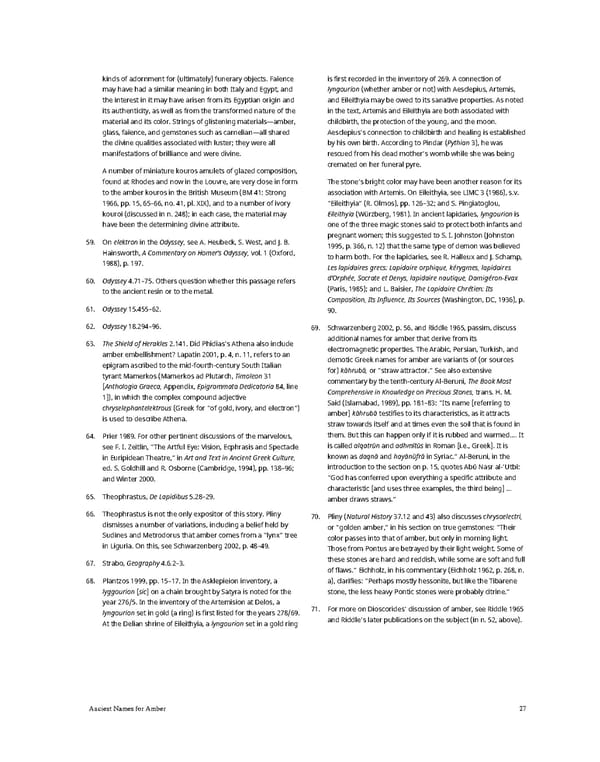kinds of adornment for (ultimately) funerary objects. Faïence is first recorded in the inventory of 269. A connection of may have had a similar meaning in both Italy and Egypt, and lyngourion (whether amber or not) with Aesclepius, Artemis, the interest in it may have arisen from its Egyptian origin and and Eileithyia may be owed to its sanative properties. As noted its authenticity, as well as from the transformed nature of the in the text, Artemis and Eileithyia are both associated with material and its color. Strings of glistening materials—amber, childbirth, the protection of the young, and the moon. glass, faïence, and gemstones such as carnelian—all shared Aesclepius’s connection to childbirth and healing is established the divine qualities associated with luster; they were all by his own birth. According to Pindar (Pythian 3), he was manifestations of brilliance and were divine. rescued from his dead mother’s womb while she was being A number of miniature kouros amulets of glazed composition, cremated on her funeral pyre. found at Rhodes and now in the Louvre, are very close in form The stone’s bright color may have been another reason for its to the amber kouros in the British Museum (BM 41: Strong association with Artemis. On Eileithyia, see LIMC 3 (1986), s.v. 1966, pp. 15, 65–66, no. 41, pl. XIX), and to a number of ivory “Eileithyia” (R. Olmos), pp. 126–32; and S. Pingiatoglou, kouroi (discussed in n. 248); in each case, the material may Eileithyia (Würzberg, 1981). In ancient lapidaries, lyngourion is have been the determining divine attribute. one of the three magic stones said to protect both infants and 59. Onelektronin the Odyssey, see A. Heubeck, S. West, and J. B. pregnant women; this suggested to S. I. Johnston (Johnston Hainsworth, A Commentary on Homer’s Odyssey, vol. 1 (Oxford, 1995, p. 366, n. 12) that the same type of demon was believed 1988), p. 197. to harm both. For the lapidaries, see R. Halleux and J. Schamp, Les lapidaires grecs: Lapidaire orphique, kérygmes, lapidaires 60. Odyssey 4.71–75. Others question whether this passage refers d’Orphée, Socrate et Denys, lapidaire nautique, Damigéron-Evax to the ancient resin or to the metal. (Paris, 1985); and L. Baisier, The Lapidaire Chrétien: Its Composition, Its Influence, Its Sources (Washington, DC, 1936), p. 61. Odyssey 15.455–62. 90. 62. Odyssey 18.294–96. 69. Schwarzenberg 2002, p. 56, and Riddle 1965, passim, discuss 63. The Shield of Herakles 2.141. Did Phidias’s Athena also include additional names for amber that derive from its amber embellishment?Lapatin 2001, p. 4, n. 11, refers to an electromagnetic properties. The Arabic, Persian, Turkish, and epigram ascribed to the mid-fourth-century South Italian demotic Greek names for amber are variants of (or sources tyrant Mamerkos (Mamerkos ad Plutarch, Timoleon 31 for) kāhrubā, or “straw attractor.” See also extensive [Anthologia Graeca, Appendix, Epigrammata Dedicatoria 84, line commentary by the tenth-century Al-Beruni, The Book Most 1]), in which the complex compound adjective Comprehensive in Knowledge on Precious Stones, trans. H. M. chryselephantelektrous (Greek for “of gold, ivory, and electron”) Said (Islamabad, 1989), pp. 181–83: “Its name [referring to is used to describe Athena. amber]kāhrubātestifies to its characteristics, as it attracts straw towards itself and at times even the soil that is found in 64. Prier 1989. For other pertinent discussions of the marvelous, them. But this can happen only if it is rubbed and warmed.… It see F. I. Zeitlin, “The Artful Eye: Vision, Ecphrasis and Spectacle is called alqatrūn and adhmītūs in Roman [i.e., Greek]. It is in Euripidean Theatre,” in Art and Text in Ancient Greek Culture, known asdaqnāandhayānūfrāin Syriac.” Al-Beruni, in the ed. S. Goldhill and R. Osborne (Cambridge, 1994), pp. 138–96; introduction to the section on p. 15, quotes Abū Nasr al-‘Utbī: andWinter 2000. “God has conferred upon everything a specific attribute and characteristic [and uses three examples, the third being] … 65. Theophrastus, De Lapidibus 5.28–29. amber draws straws.” 66. Theophrastus is not the only expositor of this story. Pliny 70. Pliny (Natural History 37.12 and 43) also discusses chrysoelectri, dismisses a number of variations, including a belief held by or “golden amber,” in his section on true gemstones: “Their Sudines and Metrodorus that amber comes from a “lynx” tree color passes into that of amber, but only in morning light. in Liguria. On this, see Schwarzenberg 2002, p. 48–49. Those from Pontus are betrayed by their light weight. Some of 67. Strabo, Geography 4.6.2–3. these stones are hard and reddish, while some are soft and full of flaws.” Eichholz, in his commentary (Eichholz 1962, p. 268, n. 68. Plantzos 1999, pp. 15–17. In the Asklepieion inventory, a a), clarifies: “Perhaps mostly hessonite, but like the Tibarene lyggourion [sic] on a chain brought by Satyra is noted for the stone, the less heavy Pontic stones were probably citrine.” year 276/5. In the inventory of the Artemision at Delos, a 71. For more on Dioscorides’ discussion of amber, see Riddle 1965 lyngourion set in gold (a ring) is first listed for the years 278/69. and Riddle’s later publications on the subject (in n. 52, above). At the Delian shrine of Eileithyia, a lyngourion set in a gold ring Ancient Names for Amber 27
 Ancient Carved Ambers in the J. Paul Getty Museum Page 36 Page 38
Ancient Carved Ambers in the J. Paul Getty Museum Page 36 Page 38